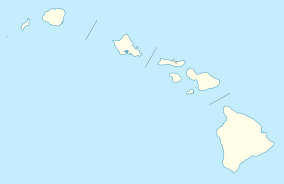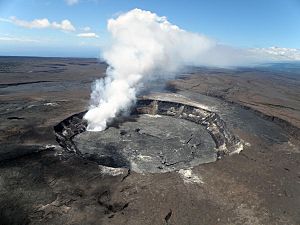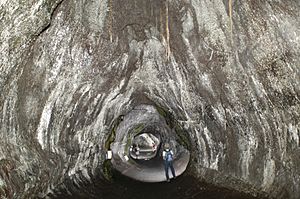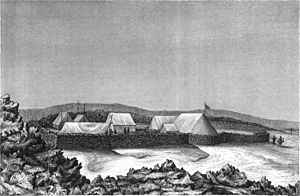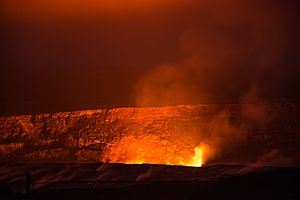Hawaiʻi Volcanoes National Park facts for kids
Quick facts for kids Hawaiʻi Volcanoes National Park |
|
|---|---|
|
IUCN Category II (National Park)
|
|

|
|
| Location | Hawaii County, Hawaii, United States |
| Nearest city | Hilo |
| Area | 354,461 acres (1,434.45 km2) |
| Established | August 1, 1916 |
| Visitors | 1,433,593 (in 2024) |
| Governing body | National Park Service |
| UNESCO World Heritage Site | |
| Criteria | Natural: viii |
| Inscription | 1987 (11th Session) |
Hawaiʻi Volcanoes National Park is a special park in the United States. It is located on the island of Hawaii. This park is home to two active volcanoes: Kīlauea and Mauna Loa. Kīlauea is one of the world's most active volcanoes. Mauna Loa is the world's largest shield volcano.
The park helps scientists learn about how the Hawaiian Islands formed. It also helps them study volcanism, which is how volcanoes work. Visitors can see amazing volcanic landscapes. They might also spot rare plants and animals. The park also shares the traditional Hawaiian culture linked to these lands.
The park first opened on August 1, 1916. It was called Hawaii National Park then. Later, it was split into this park and Haleakalā National Park. Because of its amazing natural features, Hawaiʻi Volcanoes National Park became an International Biosphere Reserve in 1980. It was also named a World Heritage Site in 1987. In 2012, the park was shown on a special quarter coin.
On May 11, 2018, parts of the park around Kīlauea volcano were closed. This was due to explosions and ash clouds from Halemaʻumaʻu crater. There were also earthquakes and road damage. The visitor center and park headquarters reopened on September 22, 2018.
As of mid-2025, most of the park is open. However, some roads and trails are still closed. The Jaggar Museum and Hawaiian Volcano Observatory buildings were too damaged in 2018. They were taken down in 2024. The eruptions and ground collapses stopped in early August 2018. Kīlauea was quiet until December 20, 2020. Since then, the crater has erupted on and off. There have been lava fountains and flows, but not as big as the 2018 events.
Contents
Exploring the Park's Environment
The park covers about 354,461 acres of land. This is a very large area! About half of the park, 130,790 acres, is a special Hawaii Volcanoes Wilderness area. This area was set aside in 1978 for hiking and camping. It includes Mokuaweoweo, the top of Mauna Loa volcano. A big part of the wilderness area also includes miles of coastline.
The park has many different environments. It goes from sea level all the way up to the top of Mauna Loa. Mauna Loa is the Earth's biggest active volcano, standing at 13,679 feet high. The weather changes a lot too. You can find lush tropical rain forests. You can also find dry, empty areas like the [[Kaʻū Desert]].
Recently, lava has erupted from Kīlauea's main caldera. Another active spot is a remote vent called [[Puʻu ʻŌʻō]].
You can enter the park from the Hawaii Belt Road. The Chain of Craters Road takes you to the coast. Along this road, you pass several craters from past eruptions. Part of this road used to go to another park entrance. But that part is now covered by lava. It can only be used for emergencies. The park's Kahuku District can be reached from Highway 11.
Park History and Culture
Long ago, Hawaiians believed Kīlauea and its Halemaʻumaʻu caldera were the sacred home of Pele. She is the goddess of volcanoes. Hawaiians would visit the crater to give gifts to Pele.
In 1790, a group of warriors, women, and children were caught in a huge eruption. Many died. Their footprints in the lava can still be seen today.
The first Western visitors came in 1823. They were William Ellis, a missionary, and Asa Thurston, an American. Ellis wrote about seeing the erupting volcano. He said it was "sublime and even appalling." He felt "astonishment and awe."
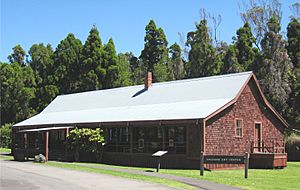
The volcano became a popular place for tourists in the 1840s. Businessmen like Benjamin Pitman and George Lycurgus ran hotels near the volcano's edge. Today, Volcano House is the only hotel inside the park.
Lorrin A. Thurston helped create the park. He was the grandson of Asa Thurston. He owned The Honolulu Advertiser newspaper and wrote articles supporting the park idea. In 1907, Hawaii paid for many members of Congress to visit the volcanoes. They even had dinner cooked over lava steam vents!
After many tries, a bill to create the park finally passed. Woodrow Wilson signed it on August 1, 1916. Hawaii National Park became the eleventh national park in the U.S. It was the first in a U.S. territory.
The park's main goal is to protect and study Kīlauea and Mauna Loa. It also aims to keep Hawaiian plants and animals safe. And it wants to preserve the traditional Hawaiian culture connected to these lands.
A few weeks later, the National Park Service was created. This service now manages all national parks. The park was officially renamed Hawaiʻi Volcanoes National Park on September 22, 1961. This happened after it was separated from Haleakalā National Park.
A lava tube in the park is named after the Thurston family. It is a cave formed by flowing lava. Part of it is open to visitors.
Painting of Pele, the Volcano Goddess

Around 1929, an artist named D. Howard Hitchcock painted Pele. She is the Hawaiian goddess of fire and volcanoes. In 1966, the painting was given to the park. It was shown in the visitor center for many years. Some people felt the painting did not show Pele with Hawaiian features.
In 2003, the Volcano Art Center held a contest. They wanted a new painting of Pele that felt more Hawaiian. A group of Native Hawaiian elders chose a painting by Arthur Johnsen. In his painting, Pele looks Polynesian. She holds a digging stick and an egg. In 2005, Johnsen's painting replaced Hitchcock's.
Kahuku District Expansion
In 2003, the park grew much larger. An extra 115,788 acres of land from Kahuku Ranch were added. This was the biggest land purchase in Hawaii's history. The park grew by 56%! This new area is called the Kahuku District. It was bought for $21.9 million.
Recent Volcanic Activity
On March 19, 2008, there was a small explosion at Halemaʻumaʻu. This was the first explosion there since 1924. Debris from the blast spread over 74 acres. Some ash fell in a nearby town. The explosion did not release lava. Scientists think it was caused by gas or water.
Before this explosion, a large amount of sulfur dioxide gas was coming from Halemaʻumaʻu. This gas is dangerous. Because of the gas, some roads and trails were closed.
In mid-May 2018, the Kīlauea area of the park closed due to more explosions. The Kahuku District stayed open. The Kīlauea area, including the visitor center, reopened on September 22, 2018. The eruptions and ground collapses stopped in early August 2018. The volcano has been much quieter since then.
In the summer of 2019, a small pond of water appeared in Halemaʻumaʻu. It grew into a small lake, about 160 feet deep by December 2020. An eruption started on December 20, 2020. The lava boiled away the lake. It then began to fill the crater with new lava.
As of mid-2025, most of the park is open. Some roads and trails are still closed. The Jaggar Museum is also closed due to damage. The Thurston Lava Tube (Nāhuku) reopened on February 21, 2020. It was fixed after many rockfalls and cracks from the 2018 earthquakes.
[[wide image|Hawaiʻi Volcanoes National Park, August 2016.jpg|800px|alt=Panorama of lava and ocean|align-cap=center|Panoramic view of the lava at the end of the Chain of Craters Road]]
In 2022, the Mauna Loa volcano erupted. This was its first eruption in many years.
Pohue Bay Expansion
The park grew again in 2022. The Trust for Public Land gave 16,451 acres of land at Pohue Bay to the National Park Service. Pōhue Bay has many important Hawaiian cultural sites. These include old quarries, lava tubes, burial sites, and fishing shrines. There are also remains of old villages and petroglyphs (rock carvings). A well-preserved part of the Ala Kahakai National Historic Trail, an ancient coastal path, runs along the bay.
The Pōhue coastline is a vital home for endangered Hawaiian animals. These include the Hawaiian hawksbill turtle and the Hawaiian monk seal. Rare red shrimp called opae'ula live in the area's anchialine ponds. Many native and migrating birds visit the bay. These include the frigate bird, white-tailed tropic bird, golden plover, wandering tattler, and black-crowned night heron.
Historic Places to Visit
Several places in the park are listed on the National Register of Historic Places listings on the island of Hawaii. These are important historical sites:
- 1790 Footprints
- Ainahou Ranch
- Ainapo Trail
- Kīlauea Crater
- Puna-Kāʻu Historic District
- Volcano House
- Whitney Seismograph Vault No. 29 at the Hawaiian Volcano Observatory
- Wilkes Campsite
Visitor Centers and Museums
The main visitor center is near the park entrance. It has displays and information about the park. The nearby Volcano Art Center is in the old 1877 Volcano House hotel. It has historical displays and an art gallery.
The Thomas A. Jaggar Museum is a few miles away. It is now closed because of damage from the 2018 eruptions. The museum used to have exhibits and a close view of Kīlauea's active vent, Halemaʻumaʻu. It was named after scientist Thomas Jaggar. He was the first director of the Hawaiian Volcano Observatory. The observatory is next to the museum. It is run by the U.S. Geological Survey and is not open to the public.
The Kilauea Military Camp offers places to stay for U.S. military members. Volunteer groups also help with events in the park.
Images for kids
-
Panoramic view of the lava at the end of the Chain of Craters Road
See also
 In Spanish: Parque nacional de los Volcanes de Hawái para niños
In Spanish: Parque nacional de los Volcanes de Hawái para niños


